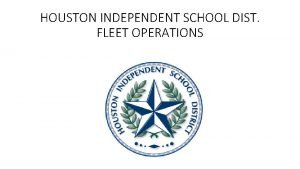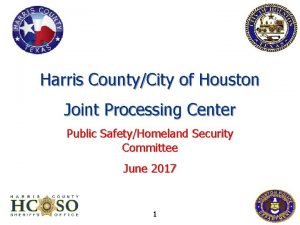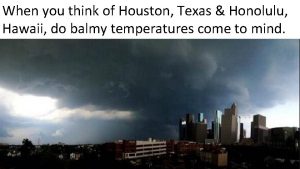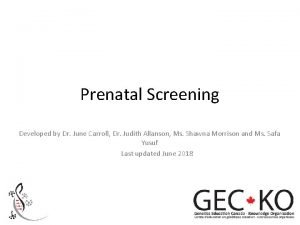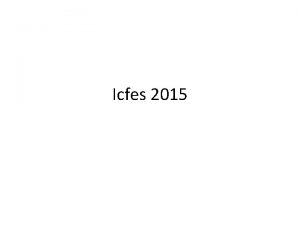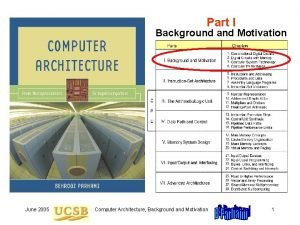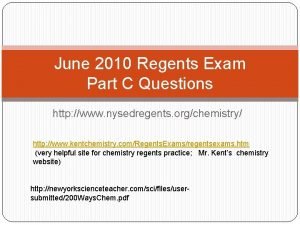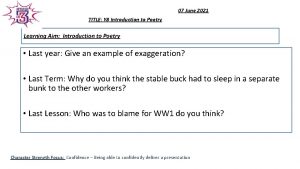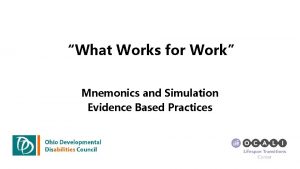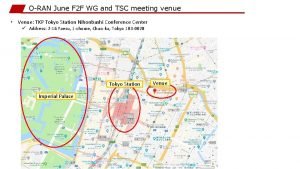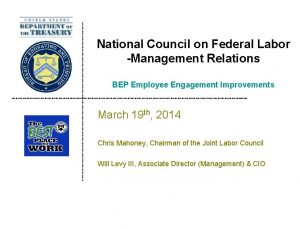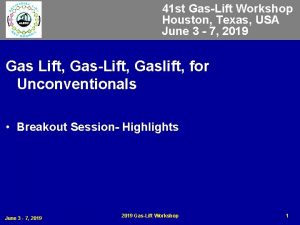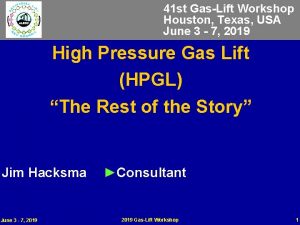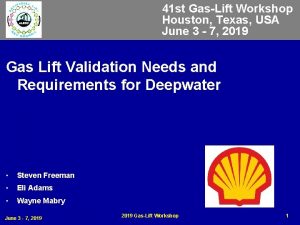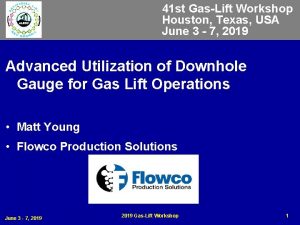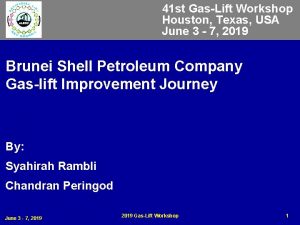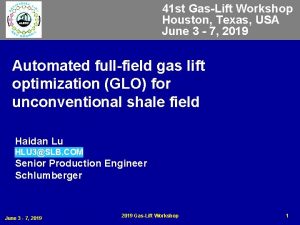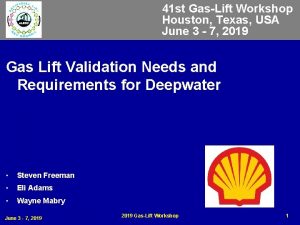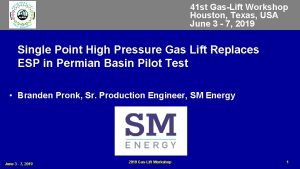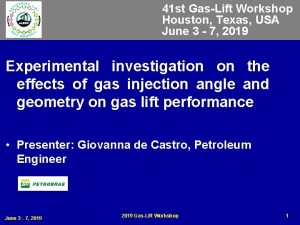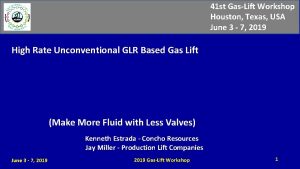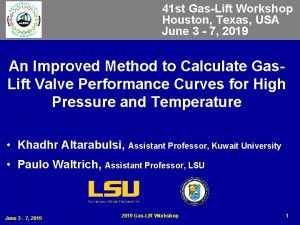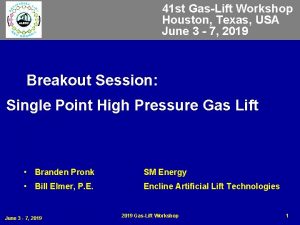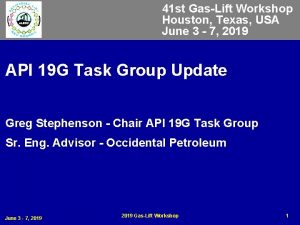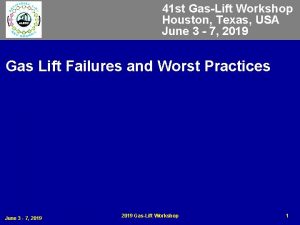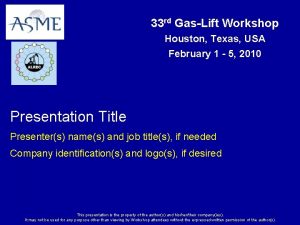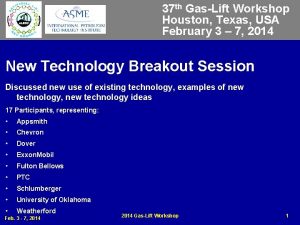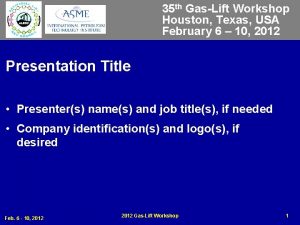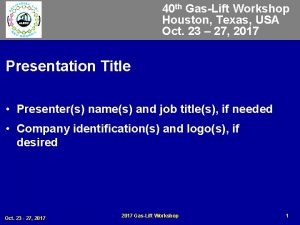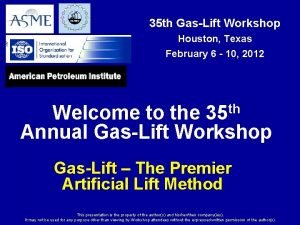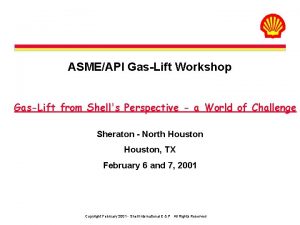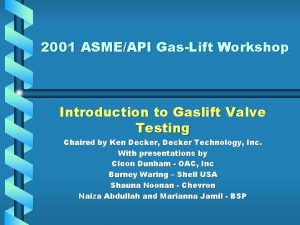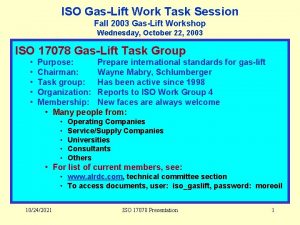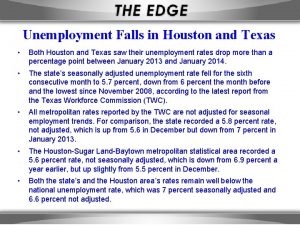41 st GasLift Workshop Houston Texas USA June

























- Slides: 25

41 st Gas-Lift Workshop Houston, Texas, USA June 3 - 7, 2019 Improving Performance of Gas Lift Compressors in Liquids-Rich Gas Service • Will Nelle Estis Compression • Bill Elmer, P. E. Encline Artificial Lift Technologies June 3 - 7, 2019 Gas-Lift Workshop 1

Outline • Financial Impact of Compressor Downtime • Understanding Compression – Designed for Gas Sales from lean gas wells – Condensation issues with liquids-rich gas • Impact of condensation to operations • Methods to mitigate operating problems • An Alternative: Prevention by design change June 3 - 7, 2019 Gas-Lift Workshop 2

Financial Impact of 5% Downtime • Gas Sales: 750 MCFPD – $3. 00 MCF, 75% NRI: $3, 420 per month • Gas Lift of 750 MCFPD – Producing 250 BOPD, 500 BWPD, 250 MCFPD – $5. 00 MCF, $50 Oil, $1 SWD, 75% NRI: $14, 415 – 4. 6 times more impact to cash flow • Rental Rate Refund for 5% Downtime – $6000 monthly rental fee x 5% = $300 June 3 - 7, 2019 Gas-Lift Workshop 3

Understanding Compression: The Phase Diagram June 3 - 7, 2019 Gas-Lift Workshop 4

Phase Diagram for 100 F Ambient Gas Well Sales (Lean 0. 65 Gravity) • Temps kept above 120 F, no hydrocarbons condense June 3 - 7, 2019 Gas-Lift Workshop 5

Phase Diagram for 30 F Ambient Gas Well Sales (Lean 0. 65 Gravity) • Temps fall below 120 F, allowing hydrocarbon condensation • Since gas is lean, not much will condense June 3 - 7, 2019 Gas-Lift Workshop 6

Liquid Dropout for 30 F Ambient Gas Well Sales – water only 4993 MSCFD 25 MSCFD 4 MSCFD 2 MSCFD June 3 - 7, 2019 Gas-Lift Workshop 7

How does this change for richer gas? 100 F Ambient (0. 76 Gravity Eagle Ford) • Temps kept above 120 F, no hydrocarbons condense June 3 - 7, 2019 Gas-Lift Workshop 8

Phase Diagram for 30 F Ambient Liquids Rich Gas (0. 76 Gravity) • Temps fall below 120 F, allowing SIGNIFICANT hydrocarbon condensation since gas is richer June 3 - 7, 2019 Gas-Lift Workshop 9

Liquid Dropout for 30 F Ambient 0. 76 SG – 3. 06% Hydrocarbons Condense 5105 MSCFPD 60 MSCFD 40 MSCFD 96 MSCFD June 3 - 7, 2019 Gas-Lift Workshop 10

Summary Table – Condensation as percentage of inlet gas volume Gas Type Gas Gravity Water Cond at 100 F Ambient HC Cond Water at 100 F Cond at Ambient 30 F Ambient HC Cond at 30 F Ambient Gas Well - Lean 0. 65 0. 46% 0 0. 62% 0 Eagle Ford - Rich 0. 76 0. 59% 0 0. 74% 3. 06% Permian – Rich 0. 80 1. 08% 0 1. 27% 7. 63% Permian – Rich+ 0. 97 1. 08% 12. 38% 1. 23% 23. 72% • Permian shows winter challenge of maintaining rich gas in vapor state June 3 - 7, 2019 Gas-Lift Workshop 11

Impact of Liquid Dropout to Operations • Frequent Interstage Scrubber Dumps – Lines cool as light ends revaporize – Freezes from inside-out, plugging line – Heat tracing and insulation helps prevent high level shutdowns June 3 - 7, 2019 Gas-Lift Workshop 12

Condensed liquids to tank? – Can overwhelm TVRU capability • 5% of 5000 MCFPD is 250 MCFPD (45 HP) • Results in excessive flaring, less gas sales – Plumb interstage scrubbers to low pressure separator upsteam of sales meter, relieving TVRU, reducing recycle – Inlet and fuel scrubbers still dump to tanks – Are your compressors pre-plumbed for this? Feb. 11 - 14, 2019 Gas-Lift Workshop 13

Impact of Liquid Dropout to Operations • Compressor output reduced – Well performance suffers – Mitigate by oversizing compressor • Safety Issues – Blowing down compressor sweeps liquids from horizontal piping onto location • Install slow rate auto blowdown into gas sales – Hydrates plug final cooler and discharge pipe • Inject Methanol June 3 - 7, 2019 Gas-Lift Workshop 14

Presence of Liquid at Wellsites – Reduces gas measurement accuracy – Gas lift valves may handle slug of liquid • If centralized compression, slugging an issue • Significant slug may cut orifice, or multipoint – Last well on common line may receive 100% of condensation June 3 - 7, 2019 Gas-Lift Workshop 15

Obvious Solution: Prevent by Elevating Gas Temperatures • Even super-rich 0. 97 gravity gas can remain vapor with 150 to 180 F temps 180 F 170 F 150 F June 3 - 7, 2019 Gas-Lift Workshop 16

What if temps could be kept in 100% Vapor range to the wellhead? • Increased compressor uptime • Minimize hydrate formation • No increase in VRU load or flare emissions • No need for methanol injection • Warm corrosion chemicals work better • No mess when blowing down compressor • No need to oversize compressor • Well performance improved • Paraffin deposition prevented June 3 - 7, 2019 Gas-Lift Workshop 17

Reality: Facility Engineers prefer old ways of centralized compression • Pipelines may cool gas to earth temp ~ 70 F Gas Type Gas Gravity Condensation % BBL per MM Eagle Ford 0. 76 3. 85% 23. 1 Permian - Rich 0. 80 8. 46% 52. 4 Permian - Rich+ 0. 97 34. 5% 216. 6 • Some of this will re-vaporize as reaches downhole temps, but how much? Wellsite compression mitigates this problem June 3 - 7, 2019 Gas-Lift Workshop 18

Barriers to Maintaining High Temps • Compressors designed for gas sales struggle to achieve high cooler outlet temps • Cooler outlet temps not normally monitored, nor controlled – Pneumatic Kimray T-12 marginal control answer – Several better methods available • Compressor industry thinks it’s not their problem, but operator gas quality issue June 3 - 7, 2019 Gas-Lift Workshop 19

Breaking down these Barriers • Educate yourself • Look at the entire picture and not compartmentalize – Compressors impact entire facility operation • Operators and compression companies need to address these problems jointly, perhaps in consortium environment • Collaborative environment will result in multiple options, and good results – Improved safety, reliability, revenue, emissions June 3 - 7, 2019 Gas-Lift Workshop 20

Suggested Changes • Refine compressor packages designs to prevent hydrocarbon condensation – Reduce cooler sizes / alternative coolers – Install automatic cooler bypasses – Install automatic louver control systems • Install near wells to prevent temp loss – Design injection piping to maintain elevated temperatures to wellhead June 3 - 7, 2019 Gas-Lift Workshop 21

Conclusions • Predictable hydrocarbon condensation occurs when compressing liquids rich gas, causing gas lift operating problems • These problems can be solved by proper engineering design • Old habits of facility engineers and most compressor rental companies adversely impact well performance, wellbore integrity, and economics, while increasing product losses, flare emissions, and safety risks June 3 - 7, 2019 Gas-Lift Workshop 22

Acknowledgements • Thanks to Branden Pronk and SM Energy for providing gas analyses and condensation data • Thanks to Estis Compression for sharing videos and ideas on improving compressor design • Thanks to Larry Harms and Jim Hacksma for collaborative work leading to this presentation Feb. 11 - 14, 2019 Gas-Lift Workshop 23

Copyright Rights to this presentation are owned by the company(ies) and/or author(s) listed on the title page. By submitting this presentation to the Gas-Lift Workshop, they grant to the Workshop, the Artificial Lift Research and Development Council (ALRDC), and the American Society of Mechanical Engineers (ASME), rights to: – Display the presentation at the Workshop. – Place it on the www. alrdc. com web site, with access to the site to be as directed by the Workshop Steering Committee. – Place it on a CD for distribution and/or sale as directed by the Workshop Steering Committee. Other uses of this presentation are prohibited without the expressed written permission of the company(ies) and/or author(s) who own it and the Workshop Steering Committee. June 3 - 7, 2019 Gas-Lift Workshop 24

Disclaimer The following disclaimer shall be included as the last page of a Technical Presentation or Continuing Education Course. A similar disclaimer is included on the front page of the Gas-Lift Workshop Web Site. The Artificial Lift Research and Development Council and its officers and trustees, and the Gas-Lift Workshop Steering Committee members, and their supporting organizations and companies (here-in -after referred to as the Sponsoring Organizations), and the author(s) of this Technical Presentation or Continuing Education Training Course and their company(ies), provide this presentation and/or training material at the Gas-Lift Workshop "as is" without any warranty of any kind, express or implied, as to the accuracy of the information or the products or services referred to by any presenter (in so far as such warranties may be excluded under any relevant law) and these members and their companies will not be liable for unlawful actions and any losses or damage that may result from use of any presentation as a consequence of any inaccuracies in, or any omission from, the information which therein may be contained. The views, opinions, and conclusions expressed in these presentations and/or training materials are those of the author and not necessarily those of the Sponsoring Organizations. The author is solely responsible for the content of the materials. The Sponsoring Organizations cannot and do not warrant the accuracy of these documents beyond the source documents, although we do make every attempt to work from authoritative sources. The Sponsoring Organizations provide these presentations and/or training materials as a service. The Sponsoring Organizations make no representations or warranties, express or implied, with respect to the presentations and/or training materials, or any part thereof, including any warrantees of title, non -infringement of copyright or patent rights of others, merchantability, or fitness or suitability for any purpose. June 3 - 7, 2019 Gas-Lift Workshop 25
 Houston isd foundation houston, tx
Houston isd foundation houston, tx 700 n san jacinto
700 n san jacinto Houston texas to hawaii
Houston texas to hawaii June ward
June ward Lottery in june corn be heavy soon
Lottery in june corn be heavy soon Holy june
Holy june Dr june carroll
Dr june carroll June 15 1215
June 15 1215 Life orientation grade 7 term 2 notes
Life orientation grade 7 term 2 notes Elephant riding in phuket icfes
Elephant riding in phuket icfes January 2018 regents chemistry
January 2018 regents chemistry June 2005 calendar
June 2005 calendar Britney spears biography
Britney spears biography Dr june james
Dr june james April may june july august
April may june july august June 22 to july 22
June 22 to july 22 June's journey
June's journey Danswer
Danswer Summary period: june 2021 poem
Summary period: june 2021 poem June canavan foundation
June canavan foundation 30 days has september
30 days has september June 21 2019 geometry regents answers
June 21 2019 geometry regents answers Companies in june
Companies in june Tsc timetable
Tsc timetable June preschool newsletter
June preschool newsletter Good morning welcome june
Good morning welcome june
